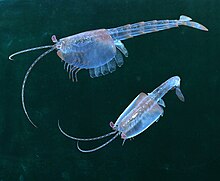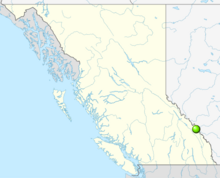Waptia
|
Waptia Temporal range: Middle Cambrian |
|
|---|---|
 |
|
| Artist's reconstruction of Waptia fieldensis | |
| Scientific classification | |
| Kingdom: | Animalia |
| Phylum: | Arthropoda |
| Clade: | Crustaceomorpha |
| Order: | †Waptiida |
| Family: | †Waptiidae |
| Genus: |
†Waptia Walcott, 1912 |
| Species: | †W. fieldensis |
| Binomial name | |
|
Waptia fieldensis Walcott, 1912 |
|
 |
|
| Location of the Burgess Shale Formation in British Columbia | |
Waptia fieldensis is an extinct species of arthropod from the Middle Cambrian Burgess Shale Lagerstätte of Canada. It grew to a length of about 8 cm (3 in) and resembled modern shrimp in both morphology and habit. It had a large bivalved carapace and a segmented body terminating into a pair of tail flaps. It was an active swimmer, feeding on organic particles it gathers from the seafloor substrate. It is also one of the oldest animals with direct evidence of brood care.
Based on the number of individuals, Waptia fieldensis is the third most abundant arthropod from the Burgess Shale Formation, with thousands of specimens collected. It was among the first fossils found by the American paleontologist Charles D. Walcott in 1909. He described it in 1912 and named it after two mountains near the discovery site – Mount Wapta and Mount Field.
Waptia fieldensis is the only species classified under the genus Waptia. Although it bears a remarkable resemblance to modern crustaceans, its taxonomic affinities remain unclear. It is currently classified as a stem group crustacean and tentatively included in the clade Crustaceomorpha.
Waptia fieldensis had a maximum body length of 8 centimetres (3.1 in). The exoskeleton was very thin and easily distorted from fossilisation. It possessed a large bivalved carapace that was narrow at the front with wide posterior margins that covered the cephalon and most of the thorax. The cephalon had five short somites (body segments) with three to five pairs of small and poorly preserved feeding appendages.
...
Wikipedia
